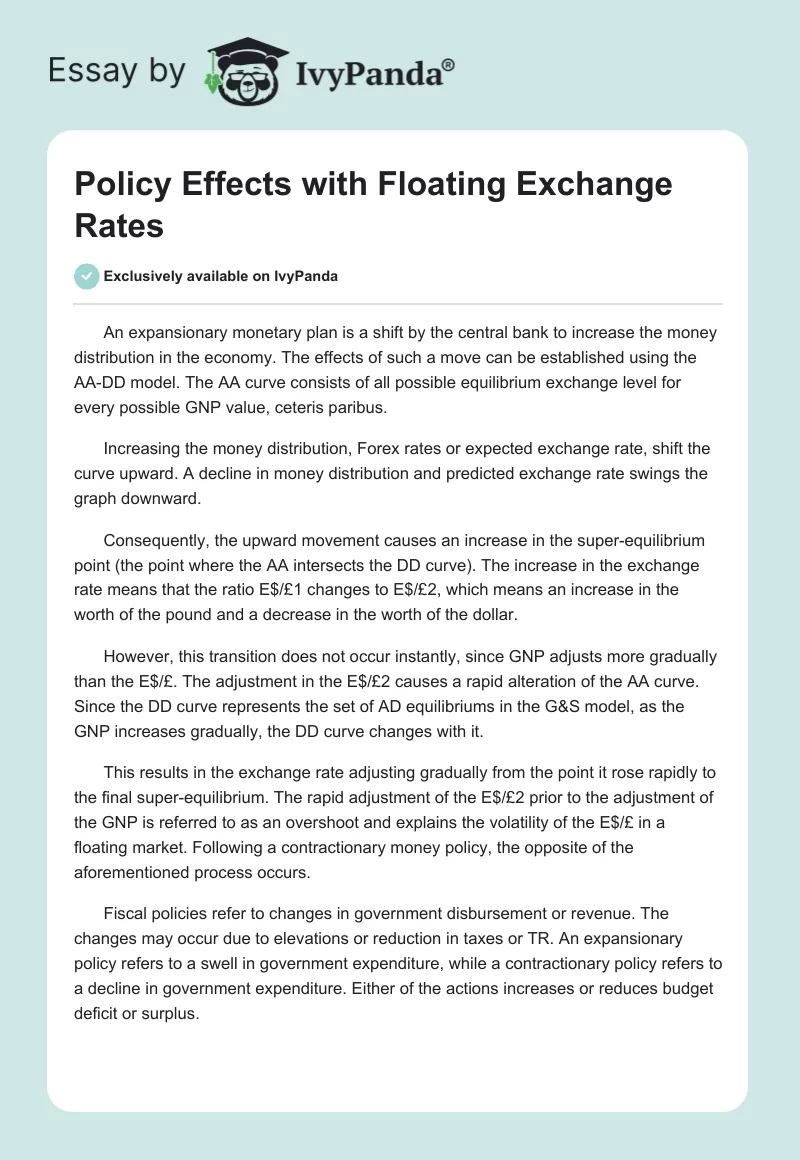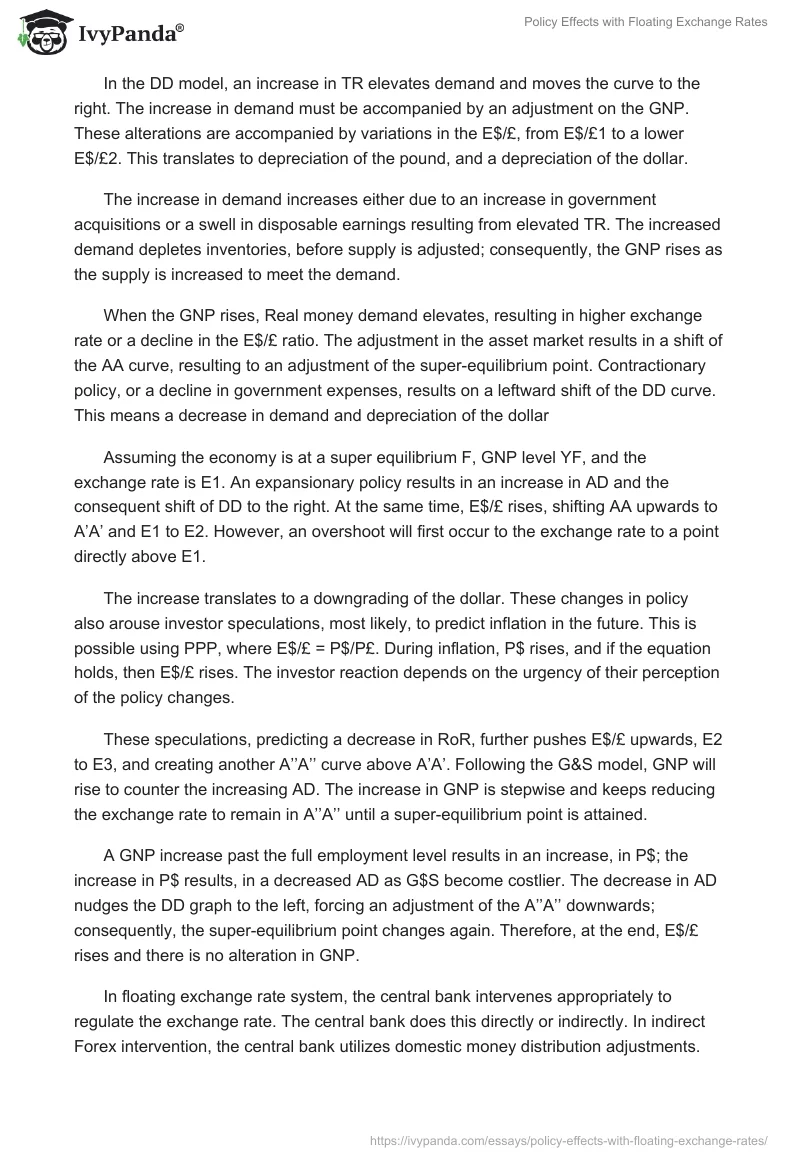An expansionary monetary plan is a shift by the central bank to increase the money distribution in the economy. The effects of such a move can be established using the AA-DD model. The AA curve consists of all possible equilibrium exchange level for every possible GNP value, ceteris paribus.
Increasing the money distribution, Forex rates or expected exchange rate, shift the curve upward. A decline in money distribution and predicted exchange rate swings the graph downward.
Consequently, the upward movement causes an increase in the super-equilibrium point (the point where the AA intersects the DD curve). The increase in the exchange rate means that the ratio E$/£1 changes to E$/£2, which means an increase in the worth of the pound and a decrease in the worth of the dollar.
However, this transition does not occur instantly, since GNP adjusts more gradually than the E$/£. The adjustment in the E$/£2 causes a rapid alteration of the AA curve. Since the DD curve represents the set of AD equilibriums in the G&S model, as the GNP increases gradually, the DD curve changes with it.
This results in the exchange rate adjusting gradually from the point it rose rapidly to the final super-equilibrium. The rapid adjustment of the E$/£2 prior to the adjustment of the GNP is referred to as an overshoot and explains the volatility of the E$/£ in a floating market. Following a contractionary money policy, the opposite of the aforementioned process occurs.
Fiscal policies refer to changes in government disbursement or revenue. The changes may occur due to elevations or reduction in taxes or TR. An expansionary policy refers to a swell in government expenditure, while a contractionary policy refers to a decline in government expenditure. Either of the actions increases or reduces budget deficit or surplus.
In the DD model, an increase in TR elevates demand and moves the curve to the right. The increase in demand must be accompanied by an adjustment on the GNP. These alterations are accompanied by variations in the E$/£, from E$/£1 to a lower E$/£2. This translates to depreciation of the pound, and a depreciation of the dollar.
The increase in demand increases either due to an increase in government acquisitions or a swell in disposable earnings resulting from elevated TR. The increased demand depletes inventories, before supply is adjusted; consequently, the GNP rises as the supply is increased to meet the demand.
When the GNP rises, Real money demand elevates, resulting in higher exchange rate or a decline in the E$/£ ratio. The adjustment in the asset market results in a shift of the AA curve, resulting to an adjustment of the super-equilibrium point. Contractionary policy, or a decline in government expenses, results on a leftward shift of the DD curve. This means a decrease in demand and depreciation of the dollar
Assuming the economy is at a super equilibrium F, GNP level YF, and the exchange rate is E1. An expansionary policy results in an increase in AD and the consequent shift of DD to the right. At the same time, E$/£ rises, shifting AA upwards to A’A’ and E1 to E2. However, an overshoot will first occur to the exchange rate to a point directly above E1.
The increase translates to a downgrading of the dollar. These changes in policy also arouse investor speculations, most likely, to predict inflation in the future. This is possible using PPP, where E$/£ = P$/P£. During inflation, P$ rises, and if the equation holds, then E$/£ rises. The investor reaction depends on the urgency of their perception of the policy changes.
These speculations, predicting a decrease in RoR, further pushes E$/£ upwards, E2 to E3, and creating another A’’A’’ curve above A’A’. Following the G&S model, GNP will rise to counter the increasing AD. The increase in GNP is stepwise and keeps reducing the exchange rate to remain in A’’A’’ until a super-equilibrium point is attained.
A GNP increase past the full employment level results in an increase, in P$; the increase in P$ results, in a decreased AD as G$S become costlier. The decrease in AD nudges the DD graph to the left, forcing an adjustment of the A’’A’’ downwards; consequently, the super-equilibrium point changes again. Therefore, at the end, E$/£ rises and there is no alteration in GNP.
In floating exchange rate system, the central bank intervenes appropriately to regulate the exchange rate. The central bank does this directly or indirectly. In indirect Forex intervention, the central bank utilizes domestic money distribution adjustments.
For example, an elevation in money distribution elevates E$/£, depreciating the dollar. However, this approach takes time because it must pass from OMO, domestic money distribution and exchange rates. Additionally, the change in domestic rates may conflict with other intentions of the government; for example, slowing or enhancing economic growth.
Indirect intervention involves the government’s entry into the private Forex market. This is achieved by trading the domestic currency. If the fed sells dollars, it swells the supply of dollars, but decreases the currency it has bought.
Consequently, if it bought pounds, the demand of pounds increases, resulting in a depreciation of the dollar. The buying of dollars, creates a deficit in dollars; consequently, raising its value. The extent of the possible intervention is dependent on the amount of assets the fed holds in pound currency, or the Forex reserve.
The direct and the indirect intervention have the same consequences, and the variance is in their timing. However, when the central bank wishes to intervene directly, leaving the domestic market intact, it carries out sterilized direct interventions; for example, selling dollars, and at the same time, selling T-bonds. The selling of dollars amplifies money supply, and selling of T-bills diminishes money supply.


